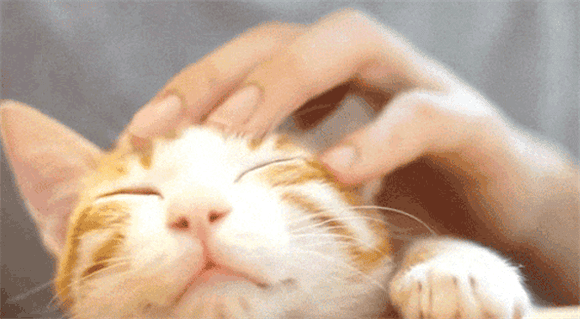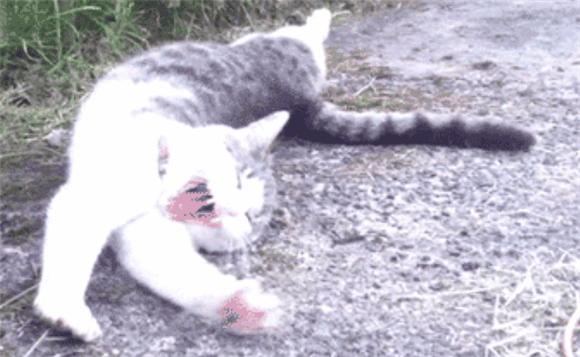Knowledge about cat behavior will often provide explanations of the meanings of common cat behaviors.
However, sometimes, some common cat behaviors may also express other meanings...
Chewing paws, snoring, stretching... may also express negative mood?
Is the cat sleeping comfortably, or is it nervous and pretending to sleep?
...
Today I will share 8 examples of "common cat behaviors expressing different meanings".

01< /p>
Paw chewing
The most common reason is, of course, simple grooming.
In addition to eating and sleeping, cats spend 50% of their waking time grooming themselves.
On the face, ears and other parts that cannot be cleaned by the tongue, cats will use their paws that have been chewed (licked) clean to clean the face.
But
A situation you may overlook: displacement behavior, that is, some cats who are in a state of fear, anxiety or high pressure will adjust by grooming. mentality.
Just like some people who bite their nails when they are nervous, grooming is an unconscious and distracting behavior for cats.
Researchers speculate that the licking touch may produce direct chemical or neural impulses to the brain, and cats can use this neural regulation to relieve stress and achieve a self-soothing effect.
02
Turn over your belly
As soon as you enter the house, the cat will lie down - roll around - and turn over on its belly for you?
Of course it’s because I feel comfortable and trust you.
The belly is a vulnerable part of a cat. Only when the cat determines that the environment and people are "safe and trustworthy" will the cat expose its belly;
Of course, in extremely special circumstances, when When a cat is suppressed by another cat, it will also express "absolute surrender" by exposing its belly.
But
Be sure not to interpret "turning my belly to express trust in you" as "inviting you to touch my belly"!
Although some cats will agree to (and enjoy) belly stroking by their owners, the vast majority of cats will just bite their hands!
Picture from: thedodo
Because this will betray the cat’s trust in you, just like some babies can only be seen, not touched.
03
Fake sleep
This is a still picture
The average daily sleep time of adult cats is 12 to 14 hours , young cats and elderly cats even sleep for 20 hours!
Unlike the two-legged social animals that “sleep for 8 hours at a stretch, then wake up and work for 16 hours”, cats follow a “sleep and wake up” pattern (wake up for 26 minutes + sleep for 78 minutes + wake up for 26 hours) minutes + 78 minutes of sleep...).
Of course not every 78 minutes is spent in deep sleep. About 9/10 of this time is spent in light sleep, or "false sleep".
But
Don’t ignore another situation: the freeze response, that is, when cats are extremely stressed and judge that they cannot escape, they will also With your eyes closed, you deceive yourself by pretending to be "sleeping", but in fact your body and mind are "awake" and ready to "escape at any time".
Backstage, parents asked, "Why was my cat so well-behaved when he went to the hospital? He closed his eyes and slept motionless...".
A cat that is so nervous that it "pretends to sleep":
The ears are turned to the sides to collect information
The front paws are not holding hands, but scratching the ground< /p>
The forelimbs and exposed abdominal/leg muscles are exerted, preparing to escape
The tail is close to the body, showing fear
04
Lick the baby Belly hair
In most cases, of course, ordinary combing~
But
Don’t ignore it: psychological hair removal. This is caused by cat mental anxiety caused by environmental stress, multi-cat households, etc., and hair loss caused by excessive licking.
How to judge?
Healthy cats can lick their fur more than 800 times a day.
So in addition to combining the number of lickings, it is also necessary to observe whether the excessive licking is fixed, check whether there is "alopecia areata", etc., and conduct a comprehensive analysis.
05
Sharpening paws
Most parents are familiar with the motivation for sharpening paws:
Marking territory. The glands between cats’ toes secrete a unique scent that contains pheromones. When sharpening the claws, the scent is released and stored in the claw marks, thereby telling "this is mine".
Mini your nails. Grind away the old cuticles on the outside of your nails to expose the new ones.
But
Sometimes polishing nails may express unpleasant emotions and relieve the mood.
Cats will even use their claws to deflect embarrassment, such as when they fail in a fight or slip and fall off the cat climbing frame...
Some cats will also When the owner is about to go out or just come home, or after being fed medicine... run to rub his paws and relax.
In fact, whether they are happy or unhappy, angry or a little nervous, cats will relieve themselves by sharpening their claws. But for situations of stress and tension, owners need to pay special attention.
06
Stretching
Sometimes cats will lean forward and stretch like doing yoga. Stretching the body allows oxygen to be supplied to the brain first and then quickly delivered to the whole body, which has the effect of "refreshing the brain".
But
Like claw grinding, stretching is sometimes done to "forcibly make the mood feel better" and to transfer embarrassment or stressful emotions. In other words, stretching in some cases is also a cat expressing his or her stress and negative emotions.
Scenes that are more likely to be seen in multi-cat households, in the wild or in shelters are:
Two cats are facing each other anxiously, and a cat next to them starts to stretch;
When it’s time to eat, if the cat bowls are placed very close to each other, or the number of cat bowls is smaller than the number of cats, the disadvantaged cats in the group will stretch and wait aside.
So, when parents see their cats stretching, they should pay more attention and make a judgment.

07< /p>
Purring
Of course, in most cases, it expresses a deep sense of satisfaction~~
But
When a cat Some cats will also purr when they go to a strange pet hospital, beg for food when they are hungry, or lie down due to fractures or injuries.
Researchers believe this is a way for cats to express "weakness and supplication." Although the frequency of purring changes when expressing satisfaction (mostly 25-150Hz when satisfied; mostly 220-520Hz when expressing weakness), in human ears, the difference is not particularly obvious.
08
Bite
When both the cat and the person are feeling happy, the cat suddenly turns around and bites you? (Some cats can’t control their strength and will bite lightly, but they won’t bite hard and won’t let go)
Passing by a cat, the cat suddenly swoops out and hugs your ankles Want a sip?
Lying in bed with a cat, the cat licks its own fur and then takes a lick at you?
Although sometimes cats bite people to express dissatisfaction.
But
the above situations usually express: Cat loves you!
It’s just that due to language barriers or inadequate social education in early childhood, the cat uses incorrect expressions.
If you encounter this situation, please provide more guidance.
Just like when we are nervous, our hands will not itch, but we will pick our fingers in unrelated actions...
Some common behaviors of cats may also express different meanings.
However, as long as we observe more and pay more attention to the cat’s meows, facial expressions, and behavioral changes, we and the cat will always have the same mind~

 扫一扫微信交流
扫一扫微信交流
发布评论